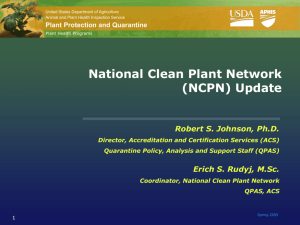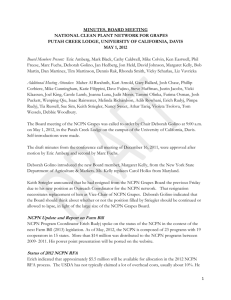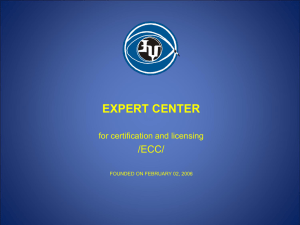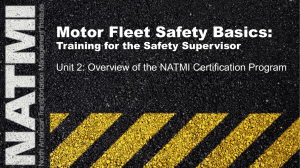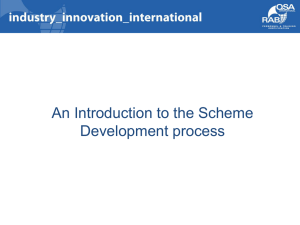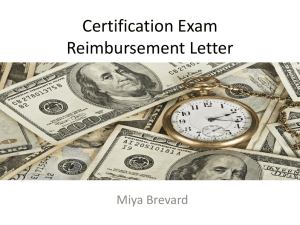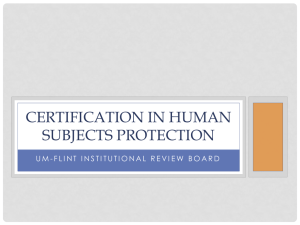National Clean Plant Network Goal #3 Workshop Break
advertisement
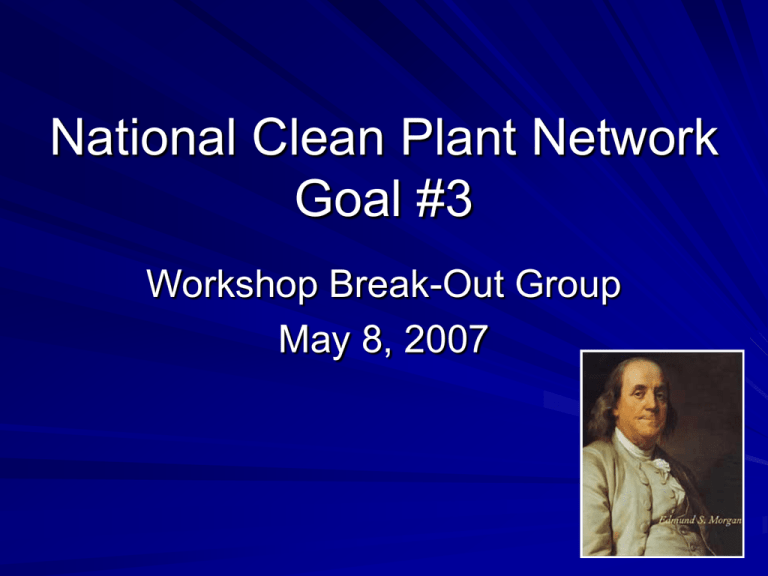
National Clean Plant Network Goal #3 Workshop Break-Out Group May 8, 2007 Our Group 3 USDA-PPQ 3 Nursery Industry 1 Peach Grower 4 State Depts. of Ag 1 Canadian 1 ARS – clonal germplasm Our Start: “The NPCN will provide foundation stock to industry within prescribed state and federal certification schemes.” What did we like about the goal? Even if it was listed as Goal #3, we were really #1 …. The reason d’etre ….The crux of the matter ….The meat and potatoes … The heart and soul Great things about Goal 3 Distributing a Product through NCPN Would make both the introduction process and generation of foundation materials more efficient Takes a good product and makes it available to the people who need it. This is where we can measure NCPN success (measureable outcome) Provides mechanism for identifying existing State/Federal/Private capabilities Solves disconnect between what we have and what we need Concerns & Questions - 1: What are the boundaries of the NCPN – who’s in, who’s not? Where are the lines between NCPN research and other research? Between NCPN standards and certification agency standards? It will be important for roles to be clearly defined. Concerns & Questions - 2: How can a national program distribute resources in a way that satisfies the disparate needs of different regions? Of different commodity groups? Advisory committees and resource allocation structures are going to have to be well crafted to adequately address needs of different regions. Changes – Additions Deletions Words, Words, Words Wording of GOAL “The NPCN will provide foundation stock to industry within prescribed state and federal certification schemes.” What does that last bit mean? Does the certification scheme have to be from a regulatory agency? Could be private, or international? Must all users of the system be within a certification scheme? Can we just remove that whole part of statement? “The NPCN will provide foundation stock to industry within prescribed state and federal certification schemes.” Our group decided the intent was that NCPN would distribute materials, abiding by any certification framework that was in place. Certification is not a function of NCPN, but NCPN must fully understand cert and work within certification parameters. Objectives - 1 3.1. The NCPN will establish collections of pathogen and pest negative cultivars based on input from the advisory committees. 3.1. The NCPN will establish collections of cultivars tested and found pest/pathogen free in accordance with NCPN standards. •The NCPN will develop a process for prioritizing what will be in a collection. Will require regional input to assess and prioritize regional needs. Regions need to communicate with one another as well as providing input to the national level. •No need for collections unless the material in them is of use to someone! •Develop plan/vision/procedure for addition of new crops under NCPN. Objectives - 2 3.2. The NCPN will maintain the collections in acceptably isolated facilities to insure the collections remain in an acceptable condition. 3.2. The NCPN will maintain collections in accordance with its established standards. •NCPN will develop standards for maintaining collections, to include site selection parameters, isolation distances, site preparation, pest monitoring, inspection and testing regimes, etc. – must meet or exceed standards of any certification requirements (international, national, state, or private entity) required for practical distribution of the collection material. Objectives - 3 3.3. The NCPN will establish working relationships with appropriate state and federal agencies that certify plants for planting. 3.3. The NCPN will establish and coordinate working relationships with and among appropriate entities that certify plants for planting. •Develop a communication plan. Engage entities that can facilitate communications, such as NPB, NASDA, to identify stakeholders. •Should lead to an Inventory of existing capabilities, roles, and authorities. •Should lead to clarify and catalog existing certification schemes, making harmonization a possibility. Objectives - 4 3.4. The NCPN will develop procedures and fee schedules for testing, therapy, maintenance and distribution of proprietary clones in cooperation with owners of those clones. 3.4. The NCPN will develop procedures and fee schedules specific to proprietary clones. Current NRSP5 practice with proprietary material is excellent model. • Objectives - 5 3.5. The NCPN will develop a transparent prioritization system for orderly distribution of plant material. That is to say, if your supply is limited, how do you decide who receives material and who doesn’t? Objectives - 6 3.6. NCPN will establish an educational and outreach program to highlight the benefits of the program. Distribution will be enhanced if nursery industry, growers, and consumers understand the benefits of using the material. Development of Best Management Practices may be part of the outreach tool to nursery industry. BENEFITS - 1 increase efficiency of clean stock production / distribution increase use of virus tested material reduce losses associated with diseases improve communication between industry and regulators interstate transparency in plant quality increase traceability of plant material BENEFITS - 2 increase trade possibilities reduce risk of invasive/exotic pathogens and pests to protect agriculture and the environment enhance economic sustainability in rural communities increase food safety and national biosecurity Thank You!
